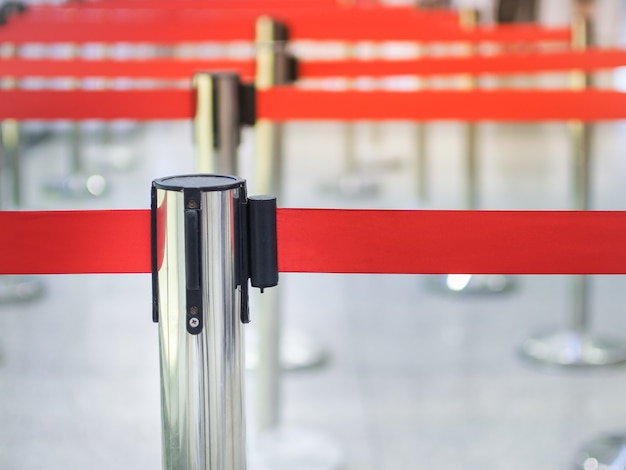The Latest Crowd Control Technologies

Over time, crowd control has evolved significantly, adapting to the changing needs and challenges of managing large gatherings. From ancient civilizations using military forces to modern approaches grounded in psychology and sociology, the understanding of crowd behavior has played a pivotal role. The development of more sophisticated strategies, including communication, negotiation, and non-violent means, has revolutionized the field. Incorporating technology and data analysis, crowd control has become more effective, aiming to ensure public safety while respecting the rights and well-being of individuals within crowds.
How to Keep Your Events Safe and Secure with the Latest Crowd Control Technologies
Here are the most popular crowd-control technologies include:
-
Access control systems: Implement ticketing systems, electronic wristbands, or RFID badges to regulate entry, prevent unauthorized access, and monitor attendee numbers.
-
Video surveillance: Strategically place CCTV cameras to monitor the event area, identify potential security threats, and record suspicious activities for later review.
-
Communication systems: Equip security personnel, event staff, and emergency responders with two-way radios or wireless communication devices to enable efficient coordination and quick response to security issues or emergencies.
-
Crowd management software: Utilize real-time data and analytics to predict and manage crowd movements, density, and behavior. This helps optimize event layout, allocate resources effectively, and identify potential overcrowding or bottleneck areas.
-
Drones for crowd control: Utilize drones equipped with cameras to provide an aerial view of the event area, enabling organizers to monitor large crowds and identify security issues quickly. Drones can also gather real-time footage during emergencies, aiding emergency responders in decision-making.
By combining these crowd control technologies, event organizers can enhance safety and security measures, ensuring a smooth and secure experience for attendees.
Thus, utilizing the latest crowd-control technologies is vital for ensuring the safety and security of events. Access control systems, video surveillance, communication devices, crowd management software, and drones all play significant roles in maintaining order and mitigating risks.
Event organizers should assess their specific needs and implement a combination of these technologies to create a secure environment for attendees. By harnessing the power of technology, events can be more enjoyable for participants while maintaining a high level of safety and security.
What are the four stages of the crowd management technique?
The crowd management technique involves a systematic approach to effectively managing crowds during events or gatherings. This technique consists of four distinct stages that help organizers maintain order, ensure safety, and enhance the overall experience for attendees. Let’s explore each stage in detail.

-
Planning and Preparation: In the context of crowd control, thorough planning and preparation are crucial. Event organizers need to anticipate the number of attendees, analyze the venue layout, and assess potential risks and challenges specific to crowded events. Considerable insight should be gained by studying previous events of similar nature and implementing guidelines for crowd management. Key considerations include identifying entry and exit points, allocating space for various activities, and determining the placement of facilities such as restrooms and first aid stations. This stage also involves establishing communication channels and coordinating with relevant stakeholders (e.g., security personnel, local authorities). Utilizing a crowd monitoring solution can provide actionable insights and real-time information on the movement and behavior of different kinds of crowds, aiding in effective planning and preparation.
-
Crowd Monitoring and Assessment: Once the event begins, the second stage involves actively monitoring and assessing the crowd. This includes keeping an eye on the density and movement of attendees, identifying potential bottlenecks or overcrowded areas, and evaluating the effectiveness of traffic flow management. Organizers may use crowd management software, video surveillance systems, and personnel stationed at strategic locations to gather real-time information. By closely monitoring the crowd, organizers can proactively address any emerging issues and make necessary adjustments to maintain a safe and comfortable environment. The crowd-monitoring solution mentioned earlier can provide actionable insights and enable organizers to adapt their crowd-management strategies based on real-time data.
-
Communication and Guidance: Effective communication is crucial for successful crowd management. The third stage involves providing clear and concise guidance to attendees. This includes utilizing signage, announcements, and digital displays to inform attendees about important information such as entry points, emergency procedures, and prohibited items. Event staff should be trained to communicate politely and effectively with attendees, answer queries, and provide directions. Communication channels, such as two-way radios or mobile apps, enable rapid information sharing among security personnel, event staff, and emergency responders, facilitating a coordinated response to any incidents or emergencies that may arise.
-
Response and Adaptation: The fourth and final stage of crowd management revolves around response and adaptation. Despite careful planning, unexpected situations can occur during events. It is essential to be prepared to respond quickly and efficiently to address these situations. This stage involves promptly identifying and resolving issues such as overcrowding, medical emergencies, or security threats. Event organizers should have contingency plans in place, outlining procedures for evacuations, crowd dispersal, or lockdowns if necessary. Regular communication with staff and ongoing monitoring of the crowd help ensure that any necessary adaptations are made in real time.
By following these four stages of crowd management, event organizers can create a safe and enjoyable environment for attendees. Effective planning, proactive crowd monitoring, clear communication, and a responsive approach to unforeseen circumstances are key elements of successful crowd management. With the right strategies and techniques in place, events can run smoothly, enhancing the overall experience for everyone involved. Read more about crowd management, from our blog ” The Do’s and Dont’s of Crowd Control.”
Emerging Technologies and Legal Considerations in Non-Lethal Crowd Control Weapons for Law Enforcement Agencies
The use of non-lethal crowd control weapons has become increasingly prevalent in law enforcement agencies, driven by emerging technologies and accompanied by important legal considerations. These futuristic weapons provide law enforcement officials with alternative means to maintain public order while minimizing the risk of fatal injuries. As police forces seek to enhance their crowd management strategies, understanding the legal frameworks surrounding the deployment of these non-lethal weapons becomes crucial.
Law enforcement agencies are recognizing the value of less-lethal weapons in effectively managing crowds. By utilizing non-lethal options, such as acoustic weapons and gunshot detection devices, law enforcement officials can address threats and disturbances without resorting to traditional firearms. These advanced technologies offer law enforcement agencies greater versatility in handling various crowd control situations, allowing them to mitigate potential risks while protecting the safety of both officers and civilians.
However, the use of non-lethal crowd control weapons must adhere to legal considerations. Law enforcement agencies operate within the boundaries set by federal legislation and local regulations. These guidelines provide clarity on the appropriate use of crowd-control weapons, emphasizing the importance of proportionality and restraint. Adhering to these legal frameworks is paramount to protecting civil liberties, preventing excessive use of force, and maintaining public trust in law enforcement practices.
As law enforcement officials utilize non-lethal weapons, they must undergo comprehensive training to ensure their proper and responsible application. Acquiring proficiency in the use of these weapons is essential for law enforcement officials, as it enables them to effectively manage crowd situations without causing unnecessary harm. Training programs focus on teaching officers the appropriate deployment techniques, potential risks and limitations of each weapon, and the importance of exercising judgment in dynamic crowd control scenarios.
Furthermore, while non-lethal crowd controls weapons offer valuable alternatives, they should not overshadow the fact that the arrest of individuals engaged in unlawful behavior may still be necessary. The ultimate objective of law enforcement agencies is to ensure public safety and uphold the rule of law. In situations where the arrest of individuals involved in criminal activity is required, law enforcement officials must employ the appropriate procedures and tactics to mitigate risks and safely apprehend the individuals involved.
To sum it up, the emergence of non-lethal crowd control weapons has presented law enforcement agencies with effective tools for maintaining public order while reducing the potential for fatal injuries. Understanding the legal frameworks and adhering to federal legislation and local regulations is essential to ensure the responsible use of these futuristic weapons. By combining advanced technologies with comprehensive training, law enforcement officials can enhance their crowd management strategies, protect civil liberties, and maintain public trust in their commitment to safety and justice.
Contact Us Today!
The latest crowd control technologies have revolutionized the way events are managed and safeguarded. Access control systems, video surveillance, communication devices, crowd management software, and drones have become indispensable tools for event organizers. These technologies provide actionable insights, enhance situational awareness, and enable efficient coordination among security personnel and event staff.
By leveraging these technologies, organizers can proactively address crowd-related challenges, ensure the safety and security of attendees, and create enjoyable experiences. The use of non-lethal crowd control weapons and their integration with advanced technologies further contribute to minimizing risks while maintaining public order.
However, it is important to recognize that the responsible and ethical use of these technologies is paramount. Compliance with legal regulations, thorough training of personnel, and adherence to established guidelines are crucial for preserving civil liberties and preventing excessive use of force.
As we continue to witness advancements in crowd control technologies, their successful implementation will rely on a balanced approach that prioritizes safety, security, and the overall well-being of event attendees. By harnessing the power of these technologies, organizers can pave the way for safer and more secure events in the future.



